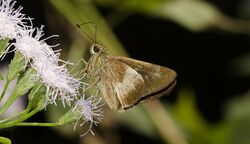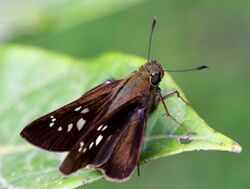Biology:Caltoris canaraica
From HandWiki
Short description: Species of butterfly
| Kanara swift | |
|---|---|

| |

| |
| Scientific classification | |
| Domain: | Eukaryota |
| Kingdom: | Animalia |
| Phylum: | Arthropoda |
| Class: | Insecta |
| Order: | Lepidoptera |
| Family: | Hesperiidae |
| Genus: | Caltoris |
| Species: | C. canaraica
|
| Binomial name | |
| Caltoris canaraica (Moore, 1883)
| |
| Synonyms | |
|
Parnara canaraica | |
Caltoris canaraica, the Kanara swift,[1] is a butterfly belonging to the family Hesperiidae.[2][1][3][4]
Distribution
This skipper is found in Southern India (Kerala, Karnataka Tamilnadu and south-western Andhra Pradesh).[1]
Description
Male and Female. Upperside dark brown, basal area olive-brown. Male: Forewing with two small oval semi-diaphanous white spots at the end of the cell, three spots obliquely before the apex, and three on the disk; hindwing without makings ; cilia brownish-cinereous. Under side paler brown, irrorated with ochreous scales which are thickly disposed along the costa and apex of forewing and across discal area of hindwing: forewing marked as above, also with a small whitish spot above hind margin: hindwing with two discal white spots. Female: forewing with larger spots than in the male, also with a minute dot beneath the lower discal spot and a triangular yellow spot above hind margin ; hindwing with three discal semi-diaphanous spots. Underside: forewing as above: hindwing with four discal white spots, and a fifth at end of the cell.—Edward Yerbury Watson[5]
Habitat: Canara (Ward)
Life cycle
Host plants
The larva (caterpillar) has been recorded on Bambusa bambos, Bambusa vulgaris and Pseudoxytenanthera monadelpha.[6]
References
- ↑ 1.0 1.1 1.2 Varshney, R.; Smetacek, P.. A Synoptic Catalogue of the Butterflies of India. (2015 ed.). New Delhi: Butterfly Research Centre, Bhimtal and Indinov Publishing. p. 59.
- ↑ Markku Savela's website on Lepidoptera Page on genus Caltoris.
- ↑ W. H., Evans (1949). A Catalogue of the Hesperiidae from Europe, Asia, and Australia in the British Museum. London: British Museum (Natural History). Department of Entomology. pp. 451. https://www.biodiversitylibrary.org/item/187283#page/475/mode/1up.
- ↑
 This article incorporates text from a publication now in the public domain: Swinhoe, Charles (1912–1913). Lepidoptera Indica. Vol. X. London: Lovell Reeve and Co.. pp. 326–327. https://www.biodiversitylibrary.org/item/103495#page/340/mode/1up.
This article incorporates text from a publication now in the public domain: Swinhoe, Charles (1912–1913). Lepidoptera Indica. Vol. X. London: Lovell Reeve and Co.. pp. 326–327. https://www.biodiversitylibrary.org/item/103495#page/340/mode/1up.
- ↑
 This article incorporates text from a publication now in the public domain: E. Y., Watson (1891). Hesperiidae Indicae : being a reprint of descriptions of the Hesperiidae of India, Burma, and Ceylon. Madras: Vest and Company. pp. 42–43. https://www.biodiversitylibrary.org/item/64080#page/56/mode/1up.
This article incorporates text from a publication now in the public domain: E. Y., Watson (1891). Hesperiidae Indicae : being a reprint of descriptions of the Hesperiidae of India, Burma, and Ceylon. Madras: Vest and Company. pp. 42–43. https://www.biodiversitylibrary.org/item/64080#page/56/mode/1up.
- ↑ Ravikanthachari Nitin; V.C. Balakrishnan; Paresh V. Churi; S. Kalesh; Satya Prakash; Krushnamegh Kunte (2018-04-10). "Larval host plants of the buterfies of the Western Ghats, India". Journal of Threatened Taxa 10 (4): 11495–11550. doi:10.11609/jott.3104.10.4.11495-11550. http://threatenedtaxa.org/index.php/JoTT/article/view/3104/4402.
Wikidata ☰ Q5024003 entry
 |

